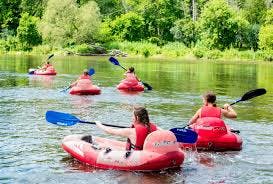How far down the Bow should you go?
The Bow River is a prominent staple for both visitors and locals of the Calgary area. There are tons of ways to enjoy the scenic sights along this river, both in the city and outside of it. Whether you’re looking for a lazy float or a thrilling rapid, the Bow has it all.

There are many put-in and take-out spots along the winding river. Depending on what type of river excursion you’re looking for, you can choose the upper or lower sections. Plus, there are a few hazardous areas to look out for. Learn more about the various access points before you float the Bow River so you can have a safe and fun adventure.
River Access Points
The city of Calgary has outlined a few access points that are best for put-in and take-out along the Bow River. Having designated access points ensures less environmental risk and improves safety for visitors. Following access point guidelines is essential to preserving the natural river environment.
You can help pose less harm to sensitive areas, plus keep wildlife, fish, and the river safe, by keeping to the following access areas:
- West Baker, Shouldice, Fish Creek, Carburn, and Edworthy Parks
- The 10th Street Wave
- Harvie Passage
- Ogden Bridge
- Glenmore Trail
- Ivor Strong Bridge
- Douglasdale North and South
- Policeman’s Flats
There are also a few popular exit points for rafters and paddlers. These include areas near Edworthy Park, Crowchild Trail, Prince’s Island Park, and the Calgary Zoo. The city of Calgary has a full list of Bow River access points here.
Bow River Hazards
There are, of course, a few hazards to be mindful of before starting your journey on the Bow River. Always check the weather and water level reports prior to heading out. There’s nothing more dangerous than high rapids and fast-flowing water, especially if you go out unprepared.
Regardless of the water level, be mindful around the 10th Street wave near Louise Bridge. A well-known access point, the 10th Street wave can be dangerous for beginner rafters or surfers. Additionally, keep watch for bridge pillars if rafting within the city limits. Hitting a pillar can cause even the sturdiest rafts to capsize. This is also the case for large rocks, trees, and waves.
The last exit on the Bow before Harvie Passage is at St. Patrick’s Island. Harvie Passage is open to float through, but caution is advised for beginners. The water of the Bow is often very cold and the current is strong, so swimming is ill-advised. You can prepare for your river trip by wearing appropriate river rafting attire and bringing a dry change of clothes for afterwards.
Float the Bow River
It’s always necessary to double check float times before heading out on the Bow. The best times for floating the Bow River depend on the water levels and flows. This is determined by recent weather and rainfall. Warm weather can even cause an increase in water level because of the natural glacier melt that feeds into the river. The highest water levels and flow rates are typically in either June or July.
Contact Lazy Day Raft Rentals to get started on your Bow River rafting adventure.
